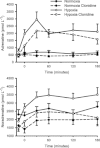Sympathetic inhibition attenuates hypoxia induced insulin resistance in healthy adult humans
- PMID: 22495590
- PMCID: PMC3424732
- DOI: 10.1113/jphysiol.2011.227090
Sympathetic inhibition attenuates hypoxia induced insulin resistance in healthy adult humans
Abstract
Acute exposure to hypoxia decreases insulin sensitivity in healthy adult humans; the mechanism is unclear, but increased activation of the sympathetic nervous system may be involved. We have investigated the hypothesis that short-term sympathetic inhibition attenuates hypoxia induced insulin resistance. Insulin sensitivity (via the hyperinsulinaemic euglycaemic clamp) was determined in 10 healthy men (age 23 ± 1 years, body mass index 24.2 ± 0.8 kg m⁻² (means ± SEM)), in a random order, during normoxia (FIO₂ =0.21), hypoxia (FIO₂ =0.11), normoxia and sympathetic inhibition (via 48 h transdermal administration of the centrally acting α2-adrenergic receptor agonist, clonidine), and hypoxia and sympathetic inhibition.Oxyhaemoglobin saturation (pulse oximetry) was decreased (P<0.001) with hypoxia (63 ± 2%) compared with normoxia (96 ± 0%), and was unaffected by sympathetic inhibition (P>0.25). The area under the noradrenaline curve (relative to the normoxia response) was increased with hypoxia (137 ± 13%; P =0.02); clonidine prevented the hypoxia induced increase (94 ± 14%; P =0.43). The glucose infusion rate (adjusted for fat free mass and circulating insulin concentration) required to maintain blood glucose concentration at 5 mmol l⁻¹ during administration of insulin was decreased in hypoxia compared with normoxia (225 ± 23 vs. 128 ± 30 nmol (kg fat free mass)⁻¹ pmol l⁻¹ min⁻¹; P =0.03), and unchanged during normoxia and sympathetic inhibition (219 ± 19; P =0.86) and hypoxia and sympathetic inhibition (169 ± 23; P =0.23). We conclude that short-term sympathetic inhibition attenuates hypoxia induced insulin resistance.
Figures




 and clonidine. NEFA: non-esterified fatty acids. PEDF: pigment epithelium derived factor. LDL: low density lipoprotein. TNFα: tumour necrosis factor α.
and clonidine. NEFA: non-esterified fatty acids. PEDF: pigment epithelium derived factor. LDL: low density lipoprotein. TNFα: tumour necrosis factor α.Similar articles
-
Effects of acute intermittent hypoxia on glucose metabolism in awake healthy volunteers.J Appl Physiol (1985). 2009 May;106(5):1538-44. doi: 10.1152/japplphysiol.91523.2008. Epub 2009 Mar 5. J Appl Physiol (1985). 2009. PMID: 19265062 Free PMC article.
-
The Effects of Sympathetic Inhibition on Metabolic and Cardiopulmonary Responses to Exercise in Hypoxic Conditions.Wilderness Environ Med. 2015 Dec;26(4):520-4. doi: 10.1016/j.wem.2015.04.004. Epub 2015 Jul 14. Wilderness Environ Med. 2015. PMID: 26183071
-
Insulin resistance and sympathetic nervous system activity in hypertensive and normotensive premenopausal women.Blood Press. 1995 Sep;4(5):287-92. doi: 10.3109/08037059509077609. Blood Press. 1995. PMID: 8535550
-
Glucose homoeostasis in rats exposed to acute intermittent hypoxia.Acta Physiol (Oxf). 2013 Sep;209(1):77-89. doi: 10.1111/apha.12118. Epub 2013 Jun 8. Acta Physiol (Oxf). 2013. PMID: 23692825
-
Increased sympathetic nervous system activity and its therapeutic reduction in arterial hypertension, portal hypertension and heart failure.J Auton Nerv Syst. 1998 Oct 15;72(2-3):210-9. doi: 10.1016/s0165-1838(98)00107-6. J Auton Nerv Syst. 1998. PMID: 9851571 Review.
Cited by
-
The Effect of Acute Continuous Hypoxia on Triglyceride Levels in Constantly Fed Healthy Men.Front Physiol. 2019 Jun 18;10:752. doi: 10.3389/fphys.2019.00752. eCollection 2019. Front Physiol. 2019. PMID: 31275165 Free PMC article.
-
Meditative Movement as a Treatment for Pulmonary Dysfunction in Flight Attendants Exposed to Second-Hand Cigarette Smoke: Study Protocol for a Randomized Trial.Front Psychiatry. 2016 Mar 22;7:38. doi: 10.3389/fpsyt.2016.00038. eCollection 2016. Front Psychiatry. 2016. PMID: 27047398 Free PMC article. Review.
-
Altitude Acclimatization Alleviates the Hypoxia-Induced Suppression of Exogenous Glucose Oxidation During Steady-State Aerobic Exercise.Front Physiol. 2018 Jul 9;9:830. doi: 10.3389/fphys.2018.00830. eCollection 2018. Front Physiol. 2018. PMID: 30038576 Free PMC article.
-
Regulators of human white adipose browning: evidence for sympathetic control and sexual dimorphic responses to sprint interval training.PLoS One. 2014 Mar 6;9(6):e90696. doi: 10.1371/journal.pone.0090696. eCollection 2014. PLoS One. 2014. PMID: 24603718 Free PMC article.
-
Brain Dopamine-Clock Interactions Regulate Cardiometabolic Physiology: Mechanisms of the Observed Cardioprotective Effects of Circadian-Timed Bromocriptine-QR Therapy in Type 2 Diabetes Subjects.Int J Mol Sci. 2023 Aug 26;24(17):13255. doi: 10.3390/ijms241713255. Int J Mol Sci. 2023. PMID: 37686060 Free PMC article. Review.
References
-
- Bell C. Pigment epithelium-derived factor: a not so sympathetic regulator of insulin resistance? Exerc Sport Sci Rev. 2011;39:187–190. - PubMed
-
- Bloomgarden ZT. Measures of insulin sensitivity. Clin Lab Med. 2006;26:611–633. - PubMed
-
- Braun B, Rock PB, Zamudio S, Wolfel GE, Mazzeo RS, Muza SR, Fulco CS, Moore LG, Butterfield GE. Women at altitude: short-term exposure to hypoxia and/or α1-adrenergic blockade reduces insulin sensitivity. J Appl Physiol. 2001;91:623–631. - PubMed
Publication types
MeSH terms
Substances
LinkOut - more resources
Full Text Sources
Other Literature Sources
Medical
Miscellaneous

